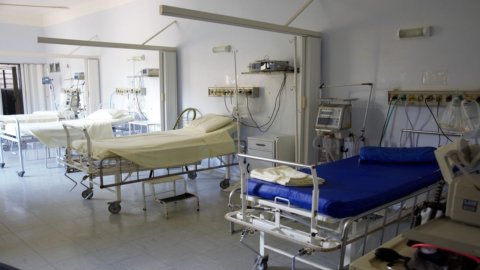Technological innovation and a more effective governance system, which rewards its implementation on the territory. This is the recipe presented by GE Healthcare Logistics, medical division of General Electric, for a More sustainable national health system, able to face the challenges of the future: population aging and growth in the number of chronically ill patients, more complex and expensive therapies, the need to optimize spending and improve clinical outcomes for patients.
Indeed, according to the 2017 edition of the Memorandum for the Sustainability of the National Health System, an optimal application of digital health systems at hospital level that generates a improvement of just 1% of efficiency would lead to savings of over 1 billion euros per year.
Healthcare expenditure in Italy
In 2016, total health expenditure (public and private) in Italy amounted to 9,2% of GDP, compared to a European average of 9,4%. Restricting the analysis to public expenditure, in Italy that for Health is 14% of the total, a lower percentage than the European average (15,2%) also in this case. Yet, from 2013 to today, health expenditure in nominal terms has increased, going from 143,6 billion euros to 149,5 billion euros in 2016, due to the aging of the population and the chronicity of many diseases, but this increase is not sufficiently supported by a parallel increase in GDP.
A situation destined to get complicated: oToday there are 65 million Italians over 13,4 (22% of the population), of which 8 out of 10 suffer from chronic diseases, with a healthcare cost equal to about 2,8 times the average per capita, destined to increase up to 3,5 in 2045.
Digital healthcare in Italy
To meet the challenges of the future, according to GE Healthcare, decisive help can come from technological innovation, in particular with the "Health Care Internet of Things”, which uses sensors, apps and remote monitoring to continuously provide clinical information, but also cloud data that allows clinicians to access the information necessary to treat patients at home, in their office or elsewhere, allowing consultation with other specialists around the world.
An optimal application of Industrial Internet systems at hospital level, which improves traceability of treatments, patient flow and use of health technologies, with an improvement of only 1% in efficiency, would translate into savings for the NHS of more than 1 billion euros a year.
On this front, however, according to GE Healthcare in Italy there is still a long way to go: digital healthcare has currently managed to overcome a minimum critical mass of affirmation only on the side of information for the patient, not on that of his management. In 2016, public expenditure for the digitization of Healthcare in Italy amounted to 1,27 billion euros, an investment which is worth approximately 1,1% of public expenditure and corresponds to 21 euros per inhabitant, a figure which is down on 5% over the previous year.
An uncomforting scenario, even if the process of digitization of Healthcare companies continues with some conviction, consisting of the electronic medical record, which used funds for 65 million euros, and the expansion of the offer of digital services to citizens, for about 14 million euros.
As far as Telemedicine is concerned, considered important by all structures operating in the healthcare sector in Italy, which have increased their investments in recent years, it is often limited to Teleconsultation alone (already fully operational in 30% of companies) while the more advanced solutions ( tele-rehabilitation and tele-assistance) are still in the experimental stage and with limited use (10% and 8% of companies).
Digital health is also Big Data Analytics (BDA) and Business Intelligence (BI). The investment in these sectors amounted to 15 million euros in 2016 and 36% of the strategic managements of healthcare companies or healthcare institutions think it is a priority to develop this sector.
There are still many unexpressed potentials of the Industrial Internet applied to the world of Healthcare. Already today, in fact, according to GE Healthcare it would be possible introduce non-experimental but innovative applications, such as:
- a different management of waiting lists, also with geolocation or on specific classes of patients, for the purpose of optimizing treatment paths and bed occupancy;
- effective monitoring of the management of prescriptive appropriateness to perform only useful, non-repetitive and absolutely necessary tests;
- the ubiquitous and real-time availability of the census and use of hospital resources;
- support for clinical decision-making processes with data-driven optimization therapy which monitors the effects brought about by telemedicine and Precision Medicine in the patient's health life.
Priorities according to GE Healthcare
To implement digital innovation, it is necessary to overcome some obstacles that sector operators mainly indicate in the lack of economic and human resources, and in the poor specific professional preparation of the insiders. It is therefore essential to invest in digital healthcare, in terms of economic but also human resources, above all to favor the decentralization of services within a NHS that is moving from a hospital-centric system to one based on the territory.
The need to exploit the potential offered by digital health is intertwined with that of encourage technological innovation to improve the care offered to patients. To achieve this goal, according to the GE Healthcare study, it is necessary to:
- combine sustainability and appropriateness by implementing innovative technologies, which contribute to increasing the possibilities of treatment and reducing the cost of managing certain pathologies.
- Introducing a correlation between the value produced for the patient in the individual services provided and the financing of the same in order to set up pay for value logics.
- Avoid the adoption of purely economic barriers that hinder the introduction of real technological innovation, using methods of evaluation and recognition of technological evolution that guarantee timely, appropriate and sustainable access for the benefit of patients.
- Overcoming the current stagnation of the systems of recognition and remuneration of technologies both in the hospital and in the local area (tariff nomenclature) in a logic of flexibility that coincides with the development of medicine and technology.
Today the weight of technologies in patient care tends to grow compared to other expenditure items and not supporting it, managing it at the same time with clinical and economic evaluation models, risks leaving our country outside the medicine of excellence.





